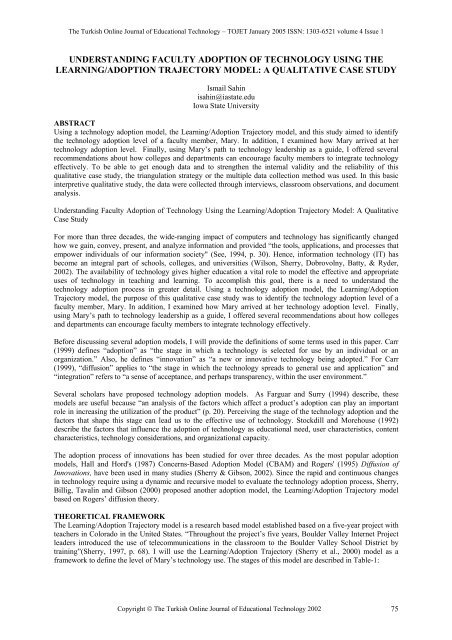Age - TOJET the Turkish online journal of educational technology
Age - TOJET the Turkish online journal of educational technology
Age - TOJET the Turkish online journal of educational technology
You also want an ePaper? Increase the reach of your titles
YUMPU automatically turns print PDFs into web optimized ePapers that Google loves.
The <strong>Turkish</strong> Online Journal <strong>of</strong> Educational Technology – <strong>TOJET</strong> January 2005 ISSN: 1303-6521 volume 4 Issue 1<br />
UNDERSTANDING FACULTY ADOPTION OF TECHNOLOGY USING THE<br />
LEARNING/ADOPTION TRAJECTORY MODEL: A QUALITATIVE CASE STUDY<br />
Ismail Sahin<br />
isahin@iastate.edu<br />
Iowa State University<br />
ABSTRACT<br />
Using a <strong>technology</strong> adoption model, <strong>the</strong> Learning/Adoption Trajectory model, and this study aimed to identify<br />
<strong>the</strong> <strong>technology</strong> adoption level <strong>of</strong> a faculty member, Mary. In addition, I examined how Mary arrived at her<br />
<strong>technology</strong> adoption level. Finally, using Mary’s path to <strong>technology</strong> leadership as a guide, I <strong>of</strong>fered several<br />
recommendations about how colleges and departments can encourage faculty members to integrate <strong>technology</strong><br />
effectively. To be able to get enough data and to streng<strong>the</strong>n <strong>the</strong> internal validity and <strong>the</strong> reliability <strong>of</strong> this<br />
qualitative case study, <strong>the</strong> triangulation strategy or <strong>the</strong> multiple data collection method was used. In this basic<br />
interpretive qualitative study, <strong>the</strong> data were collected through interviews, classroom observations, and document<br />
analysis.<br />
Understanding Faculty Adoption <strong>of</strong> Technology Using <strong>the</strong> Learning/Adoption Trajectory Model: A Qualitative<br />
Case Study<br />
For more than three decades, <strong>the</strong> wide-ranging impact <strong>of</strong> computers and <strong>technology</strong> has significantly changed<br />
how we gain, convey, present, and analyze information and provided “<strong>the</strong> tools, applications, and processes that<br />
empower individuals <strong>of</strong> our information society" (See, 1994, p. 30). Hence, information <strong>technology</strong> (IT) has<br />
become an integral part <strong>of</strong> schools, colleges, and universities (Wilson, Sherry, Dobrovolny, Batty, & Ryder,<br />
2002). The availability <strong>of</strong> <strong>technology</strong> gives higher education a vital role to model <strong>the</strong> effective and appropriate<br />
uses <strong>of</strong> <strong>technology</strong> in teaching and learning. To accomplish this goal, <strong>the</strong>re is a need to understand <strong>the</strong><br />
<strong>technology</strong> adoption process in greater detail. Using a <strong>technology</strong> adoption model, <strong>the</strong> Learning/Adoption<br />
Trajectory model, <strong>the</strong> purpose <strong>of</strong> this qualitative case study was to identify <strong>the</strong> <strong>technology</strong> adoption level <strong>of</strong> a<br />
faculty member, Mary. In addition, I examined how Mary arrived at her <strong>technology</strong> adoption level. Finally,<br />
using Mary’s path to <strong>technology</strong> leadership as a guide, I <strong>of</strong>fered several recommendations about how colleges<br />
and departments can encourage faculty members to integrate <strong>technology</strong> effectively.<br />
Before discussing several adoption models, I will provide <strong>the</strong> definitions <strong>of</strong> some terms used in this paper. Carr<br />
(1999) defines “adoption” as “<strong>the</strong> stage in which a <strong>technology</strong> is selected for use by an individual or an<br />
organization.” Also, he defines “innovation” as “a new or innovative <strong>technology</strong> being adopted.” For Carr<br />
(1999), “diffusion” applies to “<strong>the</strong> stage in which <strong>the</strong> <strong>technology</strong> spreads to general use and application” and<br />
“integration” refers to “a sense <strong>of</strong> acceptance, and perhaps transparency, within <strong>the</strong> user environment.”<br />
Several scholars have proposed <strong>technology</strong> adoption models. As Farguar and Surry (1994) describe, <strong>the</strong>se<br />
models are useful because “an analysis <strong>of</strong> <strong>the</strong> factors which affect a product’s adoption can play an important<br />
role in increasing <strong>the</strong> utilization <strong>of</strong> <strong>the</strong> product” (p. 20). Perceiving <strong>the</strong> stage <strong>of</strong> <strong>the</strong> <strong>technology</strong> adoption and <strong>the</strong><br />
factors that shape this stage can lead us to <strong>the</strong> effective use <strong>of</strong> <strong>technology</strong>. Stockdill and Morehouse (1992)<br />
describe <strong>the</strong> factors that influence <strong>the</strong> adoption <strong>of</strong> <strong>technology</strong> as <strong>educational</strong> need, user characteristics, content<br />
characteristics, <strong>technology</strong> considerations, and organizational capacity.<br />
The adoption process <strong>of</strong> innovations has been studied for over three decades. As <strong>the</strong> most popular adoption<br />
models, Hall and Hord's (1987) Concerns-Based Adoption Model (CBAM) and Rogers' (1995) Diffusion <strong>of</strong><br />
Innovations, have been used in many studies (Sherry & Gibson, 2002). Since <strong>the</strong> rapid and continuous changes<br />
in <strong>technology</strong> require using a dynamic and recursive model to evaluate <strong>the</strong> <strong>technology</strong> adoption process, Sherry,<br />
Billig, Tavalin and Gibson (2000) proposed ano<strong>the</strong>r adoption model, <strong>the</strong> Learning/Adoption Trajectory model<br />
based on Rogers’ diffusion <strong>the</strong>ory.<br />
THEORETICAL FRAMEWORK<br />
The Learning/Adoption Trajectory model is a research based model established based on a five-year project with<br />
teachers in Colorado in <strong>the</strong> United States. “Throughout <strong>the</strong> project’s five years, Boulder Valley Internet Project<br />
leaders introduced <strong>the</strong> use <strong>of</strong> telecommunications in <strong>the</strong> classroom to <strong>the</strong> Boulder Valley School District by<br />
training”(Sherry, 1997, p. 68). I will use <strong>the</strong> Learning/Adoption Trajectory (Sherry et al., 2000) model as a<br />
framework to define <strong>the</strong> level <strong>of</strong> Mary’s <strong>technology</strong> use. The stages <strong>of</strong> this model are described in Table-1:<br />
Copyright © The <strong>Turkish</strong> Online Journal <strong>of</strong> Educational Technology 2002 75
















